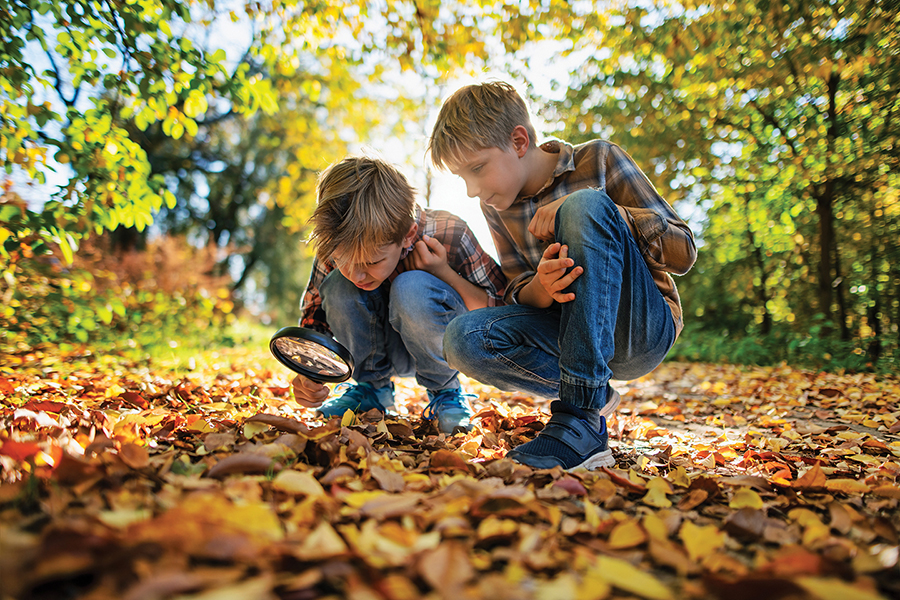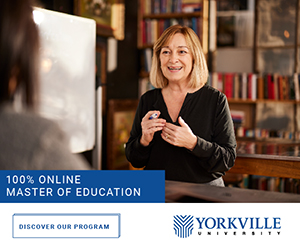An Open Invitation to Educational Leaders, Teachers, and Learners
With umbrellas protecting us from the rain, we silently followed the trail, wandering deep into the forest, through Anishnabek territory and lands protected by the Robinson Huron Treaty of 1850. We stopped at the edge of a bubbling brook, observing an abandoned picnic floating on the surface of the water, flooding caused by torrential downpours. As crime scene investigators, we investigated the plight of Abel who had gone missing (See Abel’s Island by William Steig). We asked questions of a single witness and individually wrote a preliminary report. We formed groups and compared notes, preparing a secondary report that welcomed, valued, and blended prior reports. We read these aloud as possibilities. Individual chapters (all laminated just in case) were distributed to groups of students who read and summarized the events of their chapter in three sentences. We then mingled, looking for further clues and sequencing chapters, ultimately arriving in a circle where we collectively pieced together and retold the story. Learning, engagement, laughter, and calmness entered this space outside the classroom. Despite the rain, there was a magical sense of community that was felt by all: we had accomplished a novel in a day in the great outdoors. Who would have thought?
For eighteen months and counting, the COVID-19 pandemic has limited our movements and our physical interactions, demanding that we re-assess the landscape for teaching, as well as the importance and purpose of education. Necessarily, we have asked, “Where does and can education take place? Does education, as it is, matter? Who, even what, is an educator? Is it a standardized curriculum that lays out in great detail what children and young adults should accomplish alongside their same-age peers? Is the purpose of elementary and secondary education to graduate or is education more about developing future citizens of the world who will take care of self, others, and the world around us?” As our schools were intermittently closed across the country, we explored solutions, the most common of which saw learners tethered to a computer for hours on end or buried beneath paperwork (as per Ministry guidelines). Families struggled to keep their children engaged; children struggled, many cooped up in spaces that were smaller than their classrooms; teachers struggled to reach all children, some teaching from the sidewalk; and policy makers struggled with the traditional spaces of school that were often plagued with inadequate ventilation and spaces (including buses) that did not allow for physical distancing.
Eighteen months later, and we still do not know whether we are yet done with this pandemic. And so, in the spirit of keeping our schools open, I invite a re-imagining of our educational spaces and a full consideration of the benefits that teaching and learning outdoors offers teachers and learners at all levels.
Teaching and learning outdoors is not a new phenomenon; over the years, there have been forest and nature schools, outdoor and experiential centres, and most recently organized programs to train educators how to support risky play in the outdoors (see resource list at the end). By design, some schools are fortunate to have outdoor classrooms and spaces designated for outdoor learning. Even urban schools have outdoor learning spaces; they may not be green spaces, but they are still outside. Despite this wealth of outdoor spaces, much of formal schooling continues to take place within the four walls of the classroom/school. When we do take children and young adults outside, it is most often to learn about the outdoors, to do physical education, to observe what they see, or to take a break from the demands of formal schooling.
Revisioning outdoor spaces as educational spaces that transgress curricular boundaries requires a philosophical shift away from simply learning about the outdoors toward learning about ourselves and all our relations in the outdoors, through the outdoors, with the outdoors, and on the land. Outdoor spaces invite us to awaken in our learners and in ourselves, an awareness of the world in which we live, how it functions, how we fit into the larger community of life, the role that we fulfill “in the great story of the universe, and the historical sequence of developments that have shaped our physical and cultural landscape” (Berry, 1999, p. 71). A fundamentally relational and sustainable approach, teaching and learning outdoors helps us discover that “There’s no success without the trees in all their majesty, the mountains and the rivers, the birds, the flowers, the butterflies, the bees. Without all this, we’re nothing. We don’t exist” (Berry, 1999, p. 249).
The greatest obstacle is that many confuse the notion of learning outdoors with learning about the outdoors or equating it with experiential forms of education, and they resist, saying that they are not environmentalists and they are not equipped to teach about the outdoors. Many fear inclement weather, particularly in the far north, despite the fact that learning on and with the land has been with us for all of time (see Beyond the Land Acknowledgement in the Resource List).
As educational leaders, if the goal is for our teachers to take teaching and learning outdoors, then we need to open the conversation and talk about how it is done, why it is done, what it means; we need to offer opportunities to reflect and envision teaching and learning far beyond the landscape of the classroom, and we need to offer resources that support teacher exploration. Most importantly, if we are truly committed to learning in the great outdoors, then we must be willing to take it outside if and when possible. We need to walk the talk and show how it is done, and we need never to ask others to do something we are unwilling to do ourselves. Imagine if you will: outdoor staff meetings and team building, walking performance appraisals and parent-teacher interviews, outdoor conversations with students and parents away from the oft-dreaded and power-laden office.
It is easy to make a case for outdoor teaching and learning, not just for its exploration, action, and wide-open spaces, but also for its social-emotional, well-being, and health benefits. On a cognitive level, being in the outdoors fosters wonder, questioning, consciousness, mindset, risk, determination, persistence, and mindfulness (Naht Hanh, 2011), all of which are foundational learning skills; for many, it will improve learner engagement and achievement as well as social, communication, and leadership skills. When we take teaching and learning outdoors, we move more, sit less, and play longer. Anxiety is often lessened, which results in increased resilience, self-regulation, and skills for dealing with stress. Active lifestyles are associated with improved blood pressure, cardio health, Vitamin D, and physical fitness. Teaching and learning outdoors can boost creativity, focus, as well as energy. We come to understand diversity and our interrelationship with the land. Lastly, teaching and learning outdoors weaves together the many strands for education as sustainability, helping learners to become stewards of the land and understand their place in something bigger than just them. In essence, we expand our classrooms and our worlds, one tree, one sidewalk, one sky, even one parking lot at a time.
At a time when air quality and space are at a premium, teaching and learning outdoors minimizes risk for all and solves the physical distancing issue; as we take a breath of fresh air, we break through the predictability of the four walls of our traditional educational spaces. Learners can be involved in planning, organization, and deciding how, what, when, where, even why teaching and learning can be taken outside, thus fostering a democratic classroom; expectations and responsibilities can be brainstormed with the land in mind.
On a practical level, teaching and learning outdoors is affordable and accessible (even in urban environments), and there is more than enough space for all to participate. The outdoor world (natural or humanmade) is filled with great content and great inspiration for all subjects and disciplines at all levels of education (post-secondary included); cross-curricular opportunities can include science, math, literacy, physical fitness, health, art, and so much more. It is fun, and the outdoors invites us to unplug, unless of course, we are doing a photo essay or photographing something that should not be moved! The outdoors is filled with learning opportunities that are low organization and sensory-rich, which can be as simple or as complex as we design; it is easy to use, does not require any specialized equipment, and it cleans up really well. We can go outside when it makes sense, when it facilitates real-world connections, and when it suits the lesson being learned in a meaningful and authentic way. All that is needed is a clipboard, something to sit on, appropriate clothing, sun protection, imagination, and of course, a couple of resources to support us (see the list at the end of article).
My greatest advice for educators? Take it slow, one baby step at a time. Recognize that teaching and learning outdoors requires the same skills, approaches, and competences as teaching inside; no special experience or training is required. If you are a beginner, review the list of resources and ask your school to invest in Dirty Teaching: A Beginner’s Guide to Learning Outdoors by Juliet Robertson (2014); while aimed at six- to twelve-year olds, it is easily adapted to older learners and would serve as a wonderful book club selection for school staffs. Keep it simple, concrete, and credible: start small, and increase the time spent learning outdoors when comfortable and ready. This will make the practice of learning outdoors manageable, sustainable, and tenable. Establish expectations and guidelines for being outdoors; keep routines predictable and structured; know your board’s policies and safety guidelines. And finally, anticipate the unexpected, know that some experiences don’t go as planned, recognize that some experiences will be better than others, and know that is okay. It is never a mistake, but a missed take, and with each outdoor learning opportunity, we learn what to do and what not to do. Let your learners see you as a risk-taker, a co-learner, and an adventurer in outdoor spaces. Remember that the most important part of outdoor learning is relational; we are looking for connections between people, places, and spaces.
Each time we take teaching and learning outdoors, our worlds become just a little bigger. We all benefit, we see ourselves reflected in the world around us, and we come to respect this place called home. As Walt Whitman once said, “Now I see the secret of making the best persons; it is to grow in the open air and to eat and sleep with the earth.”
Resources to Support Outdoor Learning
Beyond Land Acknowledgements:
https://etfofnmi.ca/wp-content/uploads/2019/10/Going-Beyond-A-Land-Acknowledgement-FINAL-VERSION.pdfCanada Wildlife Federation:
http://cwf-fcf.org/en/resources/for-educators/educational-units/Child and Nature Alliance:
https://childnature.caEarly Years: https://ccea.org.uk/sites/default/files/docs/curriculum/area_of_learning/fs_learning_outdoors_resource_book.pdf
Get Outdoors:
http://www.metrovancouver.org/events/school-programs/K12publications/GetOutdoors.pdfNatural Curiosity:
http://www.naturalcuriosity.ca/Outdoor Play Canada:
https://www.outdoorplaycanada.ca/resources/Parks Canada:
https://parks-parcs.ca/wp-content/uploads/2020/09/nature-playbook.pdfScotland:
https://education.gov.scot/Documents/cfe-through-outdoor-learning.pdfTake Me Outside:
http://takemeoutside.ca/Wilderdom:
http://www.wilderdom.com/
Berry, T. (2013). The great work of the new millennium. The NAMTA Journal, 38(1), 249-256. Retrieved from https://files.eric.ed.gov/fulltext/EJ1077969.pdf
Naht Hanh and the Plum Community (2011). Planting seeds: Practicind mindfulness with children. Parallax Press.
Robertson, J. (2014). Dirty teaching: A beginner’s guide to learning outdoors. Crown House Publishing.
Abel’s Island by William Steig is a story of survival. Abel, a rather well-to-do mouse was stranded on an uninhabited island in a storm. Days, then weeks and months, pass as he stubbornly attempts to find a way home. Faced with the daily adventure of survival in his solitary, somewhat hostile domain, Abel re-examines the way of life he had always accepted and discovers skills and talents within himself that hold promise of a more meaningful life (adapted from the publisher). Easily comparable with Hatchet by Gary Paulsen, and Castaway featuring Tom Hankes. If you are interested in the approach, feel free to email me at michelap@nipissingu.ca.
AUTHOR BIO:
Michelann Parr is professor in the Schulich School of Education at Nipissing University. She currently teaches in the PhD program. Primary research interests include narrative forms of inquiry, identity as lifework, sustainability as relationship with self, other, and all of creation, and family engagement through community partnerships. She has recently taken a deep dive into the pedagogy of care and what that looks like, sounds like, and feels like in higher education, particularly in online environments.












